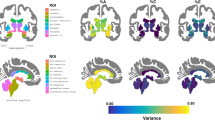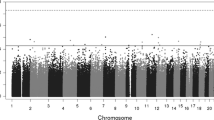Abstract
Behavioral disinhibition is a trait hypothesized to represent a general vulnerability to the development of substance use disorders. We used a large community-representative sample (N = 7,188) to investigate the genetic and environmental relationships among measures of behavioral disinhibition, Nicotine Use/Dependence, Alcohol Consumption, Alcohol Dependence, and Drug Use. First, using a subsample of twins (N = 2,877), we used standard twin models to estimate the additive genetic, shared environmental, and non-shared environmental contributions to these five traits. Heritabilities ranged from .42 to .58 and shared environmental effects ranged from .12 to .24. Phenotypic correlations among the five traits were largely attributable to shared genetic effects. Second, we used Genome-wide Complex Trait Analysis (GCTA) to estimate as a random effect the aggregate genetic effect attributable to 515,384 common SNPs. The aggregated SNPs explained 10–30 % of the variance in the traits. Third, a genome-wide scoring approach summed the actual SNPs, creating a SNP-based genetic risk score for each individual. After tenfold internal cross-validation, the SNP sumscore correlated with the traits at .03 to .07 (p < .05), indicating small but detectable effects. SNP sumscores generated on one trait correlated at approximately the same magnitude with other traits, indicating detectable pleiotropic effects among these traits. Behavioral disinhibition thus shares genetic etiology with measures of substance use, and this relationship is detectable at the level of measured genomic variation.



Similar content being viewed by others
References
Allen HL, Estrada K, Lettre G, Berndt SI, Weedon MN, Rivadeneira F, Consortium P (2010) Hundreds of variants clustered in genomic loci and biological pathways affect human height. Nature 467(7317):832–838. doi:10.1038/Nature09410
Aulchenko YS, Ripke S, Isaacs A, van Duijn CM (2007) GenABEL: an R library for genome-wide association analysis. Bioinformatics 23(10):1294–1296. doi:10.1093/bioinformatics/btm108
Bierut LJ, Goate AM, Breslau N, Johnson EO, Bertelsen S, Fox L, Edenberg HJ (2012) ADH1B is associated with alcohol dependence and alcohol consumption in populations of European and African ancestry. [Meta-Analysis Research Support, N.I.H., Extramural]. Mol Psychiatry 17(4):445–450. doi:10.1038/mp.2011.124
Boker S, Neale M, Maes H, Wilde M, Spiegel M, Brick T, Fox J (2011) OpenMx: an open source extended structural equation modeling framework. Psychometrika 76(2):306–317. doi:10.1007/s11336-010-9200-6
Breiman L, Spector P (1992) Submodel selection and evaluation in regression—the X-random case. Int Stat Rev 60(3):291–319
Franke A, McGovern DPB, Barrett JC, Wang K, Radford-Smith GL, Ahmad T, Parkes M (2010) Genome-wide meta-analysis increases to 71 the number of confirmed Crohn’s disease susceptibility loci. Nat Genet 42(12):1118–1125. doi:10.1038/Ng.717
Furberg H, Kim Y, Dackor J, Boerwinkle E, Franceschini N, Ardissino D, Sullivan PF (2010) Genome-wide meta-analyses identify multiple loci associated with smoking behavior. Nat Genet 42(5):441–447. doi:10.1038/ng.571
Hastie T, Tibshirani R, Friedman JH (2009) The elements of statistical learning: data mining, inference, and prediction, 2nd edn. Springer, New York
Hicks BM, Schalet BD, Malone SM, Iacono WG, McGue M (2011) Psychometric and genetic architecture of substance use disorder and behavioral disinhibition measures for gene association studies. Behav Genet 41(4):459–475. doi:10.1007/s10519-010-9417-2
Hirschhorn JN, Daly MJ (2005) Genome-wide association studies for common diseases and complex traits. Nat Rev Genet 6(2):95–108. doi:10.1038/Nrg1521
Iacono WG, McGue M (2002) Minnesota twin family study. Twin Res 5(5):482–487
Iacono WG, Malone SM, McGue M (2008) Behavioral disinhibition and the development of early-onset addiction: common and specific influences. Annu Rev Clin Psychol 4:325–348. doi:10.1146/annurev.clinpsy.4.022007.141157
Kendler KS, Jacobson KC, Prescott CA, Neale MC (2003a) Specificity of genetic and environmental risk factors for use and abuse/dependence of cannabis, cocaine, hallucinogens, sedatives, stimulants, and opiates in male twins. Am J Psychiatry 160(4):687–695
Kendler KS, Prescott CA, Myers J, Neale MC (2003b) The structure of genetic and environmental risk factors for common psychiatric and substance use disorders in men and women. Arch Gen Psychiatry 60(9):929–937
Luczak SE, Glatt SJ, Wall TL (2006) Meta-analyses of ALDH2 and ADH1B with alcohol dependence in Asians. Psychol Bull 132(4):607–621
Manolio TA, Collins FS, Cox NJ, Goldstein DB, Hindorff LA, Hunter DJ, Visscher PM (2009) Finding the missing heritability of complex diseases. Nature 461(7265):747–753. doi:10.1038/Nature08494
McGue M, Zhang Y, Miller MB, Basu S, Vrieze SI, Hicks B, Malone S, Oetting WS, Iacono WG (in press) A genome-wide association study of behavioral disinhibition. Behav Genet
Miller MB, Basu S, Cunningham J, Eskin E, Malone SM, Oetting W, Schork N, Sul JH, Iacono WG, McGue M (2012) The Minnesota Center for twin and family research genome-wide association study. Twin Res Hum Genet 15(6):767–774
Neale MC, Cardon LR (1992) Methodology for genetic studies of twins and families. Kluwer, Dortrecht
Price AL, Patterson NJ, Plenge RM, Weinblatt ME, Shadick NA, Reich D (2006) Principal components analysis corrects for stratification in genome-wide association studies. Nat Genet 38(8):904–909
Schumann G, Coin LJ, Lourdusamy A, Charoen P, Berger KH, Stacey D, Elliott P (2011) Genome-wide association and genetic functional studies identify autism susceptibility candidate 2 gene (AUTS2) in the regulation of alcohol consumption (vol 108, pg 7119, 2011). Proc Natl Acad Sci USA 108(22):9316–9320. doi:10.1073/pnas.1106917108
Speliotes EK, Willer CJ, Berndt SI, Monda KL, Thorleifsson G, Jackson AU, Magic (2010) Association analyses of 249,796 individuals reveal 18 new loci associated with body mass index. Nat Genet 42(11):U937–U953. doi:10.1038/ng.686
R Development Core Team (2011) R: A language and environment for statistical computing
Teslovich TM, Musunuru K, Smith AV, Edmondson AC, Stylianou IM, Koseki M, Kathiresan S (2010) Biological, clinical and population relevance of 95 loci for blood lipids. Nature 466(7307):707–713. doi:10.1038/Nature09270
Visscher PM, Brown MA, McCarthy MI, Yang J (2012) Five years of GWAS discovery. Am J Hum Genet 90(1):7–24. doi:10.1016/j.ajhg.2011.11.029
Voight BF, Scott LJ, Steinthorsdottir V, Morris AP, Dina C, Welch RP, Consortium G (2010) Twelve type 2 diabetes susceptibility loci identified through large-scale association analysis. Nat Genet 42(7):579–589. doi:10.1038/Ng.609
Vrieze SI (2012) Model selection and psychological theory: a discussion of the differences between the Akaike Information Criterion (AIC) and the Bayesian Information Criterion (BIC). Psychol Methods 17(2):228–243
Vrieze SI, McGue M, Miller MB, Legrand LN, Schork NJ, Iacono WG (2011) An assessment of the individual and collective effects of variants on height using twins and a developmentally informative study design. PLoS Genet 7(12):e1002413
Vrieze SI, Hicks BM, McGue M, Iacono WG (2012a) Genetic influence on the co-occurrence of alcohol, marijuana, and nicotine dependence symptoms declines from age 14 to 29. Am J Psychiatry 169:1073–1081
Vrieze SI, Iacono WG, McGue M (2012b) Confluence of genes, environment, development, and behavior in a post-GWAS world. Dev Psychopathol 24(4):1195–1214
Vrieze SI, McGue M, Iacono WG (2012c) The interplay of genes and adolescent development in substance use disorders: leveraging findings from GWAS meta-analyses to test developmental hypotheses about nicotine consumption. Hum Genet 131(6):791–801
Yang JA, Benyamin B, McEvoy BP, Gordon S, Henders AK, Nyholt DR, Visscher PM (2010) Common SNPs explain a large proportion of the heritability for human height. Nat Genet 42(7):565–569. doi:10.1038/Ng.608
Yang JA, Lee SH, Goddard ME, Visscher PM (2011a) GCTA: a tool for genome-wide complex trait analysis. Am J Hum Genet 88(1):76–82. doi:10.1016/j.ajhg.2010.11.011
Yang JA, Manolio TA, Pasquale LR, Boerwinkle E, Caporaso N, Cunningham JM, Visscher PM (2011b) Genome partitioning of genetic variation for complex traits using common SNPs. Nat Genet 43(6):519–525. doi:10.1038/Ng.823
Young SE, Stallings MC, Corley RP, Krauter KS, Hewitt JK (2000) Genetic and environmental influences on behavioral disinhibition. Am J Med Genet 96(5):684–695. doi:10.1002/1096-8628(20001009)96:5<684:AID-AJMG16>3.0.CO;2-G
Zucker RA, Heitzeg MM, Nigg JT (2011) Parsing the undercontrol/disinhibition pathway to substance use disorders: a multilevel developmental problem. Child Dev Perspect 5(4):248–255. doi:10.1111/j.1750-8606.2011.00172.x
Zuk O, Hechter E, Sunyaev SR, Lander ES (2012) The mystery of missing heritability: genetic interactions create phantom heritability. Proc Natl Acad Sci USA. doi:10.1073/pnas.1119675109
Acknowledgments
Support was provided by grants DA05147, AA09367, AA11886, DA13240, DA024417, MH66140, and MH017069 (SIV). We also thank Scott Sponheim for valuable laboratory support.
Conflict of interest
No Authors have any conflict of interest in the present work.
Author information
Authors and Affiliations
Corresponding author
Additional information
Edited by Deborah Finkel.
Rights and permissions
About this article
Cite this article
Vrieze, S.I., McGue, M., Miller, M.B. et al. Three Mutually Informative Ways to Understand the Genetic Relationships Among Behavioral Disinhibition, Alcohol Use, Drug Use, Nicotine Use/Dependence, and Their Co-occurrence: Twin Biometry, GCTA, and Genome-Wide Scoring. Behav Genet 43, 97–107 (2013). https://doi.org/10.1007/s10519-013-9584-z
Received:
Accepted:
Published:
Issue Date:
DOI: https://doi.org/10.1007/s10519-013-9584-z




